The boned bodice is made of cream silk satin. The bodice and sleeves are flatlined to a twill weave that is light-weight and appears to be made of silk or silk blend. The back of the original can be seen in Image 1 Below. Due to the color, fabric, and style, it is believed to be a wedding bodice from the late 1880s. Queen Victoria popularized the wearing of white or cream when she married Prince Albert in 1840; those colors continue to dominate gowns worn by brides today.
The bodice is cut with fullness concentrated below the waist on the back, side back, and back panels of the bodice. The exaggerated tail shape accommodates the bodice which would be worn over top of a corset and bustle cage. The bodice was made for a petite figure. It is difficult to display on a form due to its fragile state and because it is smaller than a modern size 2 Wolf dress form which measures with a bust of 33 inches, a waist at 24 inches and hips at 34 inches. The bodice has a 23" waist. It is short waisted, measuring 13" from back neck to waist. A modern back neck to waist measurement is generally 15" long.
Figure 1: Bodice Back |
 |
Bodice Details: Interior and Exterior
This bodice opens center front with ten buttons that measure 5/8" in width. They are self-fabric covered buttons with a small shank. There is a wide extension beyond the button placement, utilizing the selvedge edge of the fabric. The buttons are set on a curve, rather than a straight line, as can be seen in Figures 2, 3, and 4 below. The button placement curves inward to emphasize the smallest point at the waist, which would have been cinched in with a corset. The accompanying buttonholes' extension and facing utilizes the selvedge of the fabric. There is a slight extension beyond the buttonholes measuring at most 1/4" from the edge, where it is folded and turned back to reinforce the buttonhole, as can be seen in Figure 3 below. The buttonholes are hand-bound and have a keyhole shape, as show in Figure 4 below.
Figure 2: Buttons |
Figure 3: Buttonhole
|
Figure 4: Buttonhole
|
 |
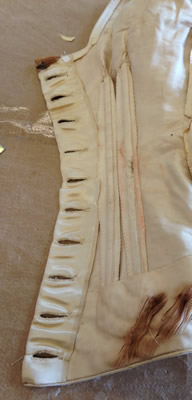 |
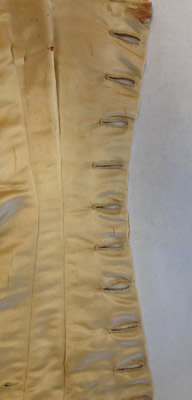 |
The front panel, as seen in Figure 5 below, has two darts that extend to the traditional side seam placement. The two darts allow shaping without having a side front panel. The neckline is quite low and squared off. The neckline and hems are finished with a self-fabric covered cording. It is a narrow cotton twist cord measuring 1/8" wide when applied. The cording was applied by machine and hand-finished on the inside by turning the bias seam allowance under to a 1 1/2" wide finish. The bottom hem of the bodice is corded and then faced with the fabric used for flat-lining, finishing at 3" above the bottom edge.
The bodice is comprised of eight panels and is fully boned. There are a total of nine spiral bones that vary in length throughout the eight bodice panels. The bone casings are made of the same material as the flat-lining. They have been machine stitched to the seam allowance on the front darts, side seams, side back, and center back seams. Starting on the front of the bodice, bone casings were applied to the two darts; the dart closest to center front has a 9" bone and the other ne has an 8 3/4" bone. ON the side seam there is a 9 1/2" bone. On the side there is a 1-" bone. There is also a 9" bone at center back. The bone placement is indicated on the accompanying pattern with asterisks.
The back interior, as Figure 6 below illustrates, has a combination of hand and machine sewing used to construct the bodice. Seams were stitched by machine and finished with a fine overcast stitch done by hand.
Figure 5: Front Interior |
Figure 6: Back Interior |
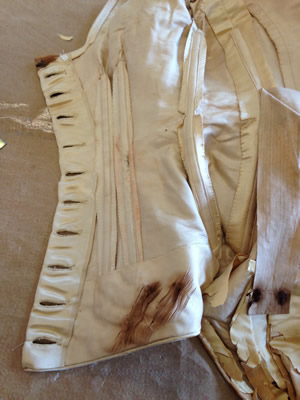 |
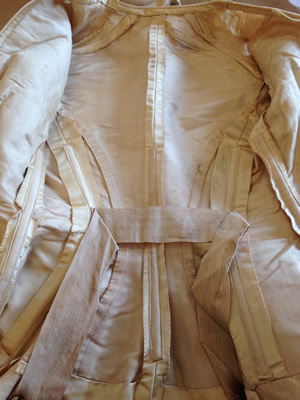 |
Bow Detail
The six back panels narrow and emphasize the waistline. From below the waistline the panels widen and are shaped, as can be seen in Figure 7 below. This image also shows some of the garment deterioration exposed when the hemline pleating was examined to take a pattern from the garment.
The center back hemline was pleated with two returns to created decorative tails. Self-fabric tubes measuring 2 1/4" wide were pressed flat, pleated, tucked, and wrapped into unique decorative bows. The bows utilize the silk for self-fabric fringe. The fringe varies in length from 1/2" to 1" in length. Figures 7 and 8 below show this decorative feature.
Figure 7: Back Interior Detail |
Figure 8: Exterior Bow Detail |
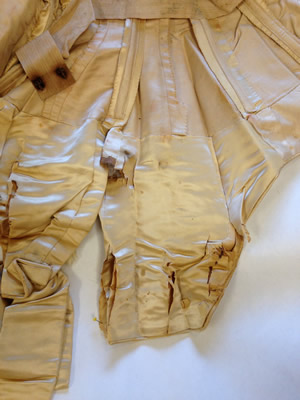 |
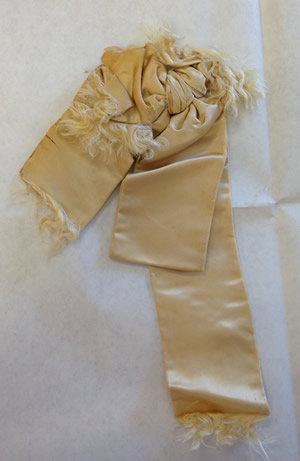 |
Sleeves
The sleeves are flat-lined with the same material as the rest of the bodice. They have a simple two-piece design and have slight easing at the elbow along the overarm seam, as can be seen in Figure 1 above. They are elbow length and are fitted into the shoulder without ease. The sleeve hems are clean finished with a bias facing and are not corded.
Collar
There is a decorative one-inch wide collar that is topically applied, but it is not at all finished to the same extent as the rest of the garment. The top and front edges are finished, made of the fashion fabric but the bottom hem is left as a raw cut and unfinished, indicating that it was possibly added at a later time, although it was made of the same fashion fabric as the bodice.
Damage
The bodice is in poor condition. The silk is shattering in a variety of areas and is very fragile. The deterioration is most concentrated on the right sleeve, the left hip area and at the back hem. It is also at the back hem where the fabric has disintegrated and the cording is no longer attached to the garment. There are also red stains on the left sleeve and bodice front.
The bodice flat-lining has held up well during its many years in storage which made it possible to get a pattern from this deteriorating garment. There are also rust stains from the metal hook and eye closures on the interior belt. Some of the buttonholes have worn and cut through the extension so they no longer function.
© Katie Keener, 2016

